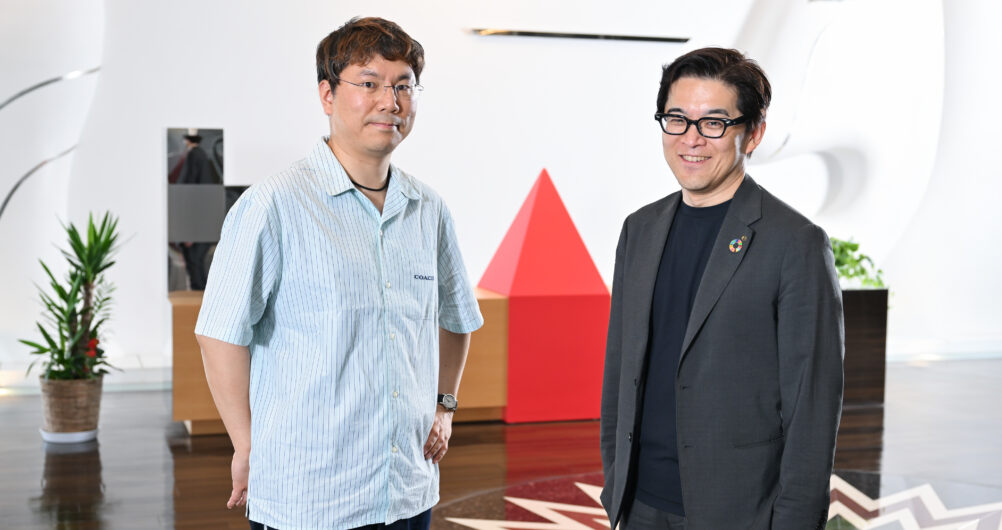Hiroyuki Kobayashi & Game Producers Interview Part 5
Having produced numerous hit titles, Hiroyuki Kobayashi now serves as the President and CEO of GPTRACK50. This fifth installment of the ongoing interview series pairs Kobayashi with fellow leading creators from the industry. This time, his conversation partner is Yosuke Hayashi, Executive Vice President and Head of AAA Studio at KOEI TECMO GAMES. Together, they discuss their respective approaches to creative work and the evolving role of the producer.
Hiroyuki Kobayashi
GPTRACK50 President
At Capcom, has been involved in many popular series such as “Resident Evil” and “Sengoku BASARA.” In 2022, established the game studio “GPTRACK50” and is currently developing a completely new title.
Yosuke Hayashi
KOEI TECMO GAMES Director & Executive Vice President
Representative of AAA Games Studio in the Entertainment Division
A veteran of Team NINJA, Hayashi has served as producer and director on series such as Dead or Alive, NINJA GAIDEN, and Nioh. He is currently developing Hyrule Warriors: Lost Seals.
“Making Headlines Is a Calculated Craft”
— Hayashi Resonates with Kobayashi’s Production Philosophy
Hayashi: We first met back in 2012, during a press tour organized by a console platformer. Resident Evil 6 was the highlight of the event, and I remember being introduced to you then.
Kobayashi: Yes, that was in Singapore, if I recall correctly.
Hayashi: We were showcasing Dead or Alive 5 at the time. I remember you left a strong impression—there was something different about your presence compared to other producers.
Kobayashi: Were you already working as a producer back then?
Hayashi: Originally, I came up through the development side—as a planner and director. After our company merged with another, I was appointed producer. So, when we met, I was still fairly new to the role and figuring things out. I didn’t have a clear grasp of what it meant to be a producer or how to create tangible results. Around that time, I often saw your work in the media and found inspiration in how you approached user outreach and built buzz around titles. In a way, I was learning from you as a prime example of what a producer should be.
Kobayashi: By that time, we were well past the era when “a good game sells itself.” Making a great game was just the baseline—there was an entirely separate skill set required to deliver it to players. I started developing my own theories on producing and testing them through practice.
Hayashi: There are many kinds of producers, each with their own approach, but I always got the sense that you calculated how to generate buzz.
Kobayashi: I was experimenting with a lot back then. Rather than following the norms of the game industry, I looked at how other entertainment sectors—films, anime, music—handled promotion and marketing. I studied what they did, thinking we could apply those methods to games and create something new. I tried to find the best promotional approach for each title and executed it.
Hayashi: Things like incorporating popular musicians for theme songs or opening with animated sequences—you made memorable choices.
Kobayashi: This may apply more to KOEI TECMO GAMES as a whole than to you personally, but I’ve been impressed by your aggressive push into original IP in recent years. Even major publishers tend to shy away from new IP these days, so your proactive stance really stands out. Given your prominent role, I’ve always imagined you’re deeply committed to development.
Hayashi: We do have several long-standing franchises, but from a global standpoint, we lack a “super-strong” IP that commands worldwide attention. So we thought—why not leverage our current development power to create one? That led to a company-wide initiative where each brand team began actively developing new titles, while still valuing existing IP. Our strength also lies in the consistent tone across our games—there’s a distinct “oriental” flavor that aligns with the company’s brand. In an age when Asian content is increasingly in the global spotlight, building on that identity is not just a strategy for survival—it’s also a major opportunity. We approach it with a strong sense of purpose.
Always Aiming for Catchy Messaging
Unpacking the Establishment of the AAA Studio
Kobayashi: In addition to your existing brand groups, your company established a new AAA Studio in 2024. You’re leading that studio—what was the reasoning behind forming it as a “studio” instead of another “brand”?
Hayashi: A few years back, we launched a brand called midas, primarily focused on smartphone game development. One of the titles from that brand, Nobunaga’s Ambition: Shutsujin, fortunately performed quite well. Building on that success, we asked ourselves at Koei Tecmo, “What should we challenge ourselves with next?” The answer was to expand our lineup of globally successful titles.
On a personal level, I’ve always felt that if we’re going to go through the effort of making games, I want as many people as possible to play them. It’s incredibly rewarding as a creator to have people from all over the world enjoy something you’ve worked hard to make and to hear their feedback. That benefits not just us, but the players, the company, and everyone involved. With that in mind, we decided that forming a new studio, distinct from our existing brands, was the best path forward.
Kobayashi: So rather than focusing on expanding existing titles, you’re nurturing entirely new IPs from scratch. Calling it a “studio” instead of a brand certainly communicates a different set of expectations and makes a stronger impression.
Hayashi: Since we were creating something new, we wanted to ensure it became newsworthy—even on the internet. Back when we developed the Soft Engine (※), it became a sort of internet meme. We figured even if it ended up like that again, as long as people remembered the name and it became a talking point among game fans, that would be a win. That’s why we chose the name “AAA Studio.” It’s clear, has a positive ring to it, and we hoped it would stick in people’s minds.
Of course, choosing such a bold name meant we had to live up to it. It’s been a good motivator for the team, and thanks to the name, the studio has already generated a fair bit of buzz—essentially serving as its own promotional tool.
Kobayashi: It’s definitely a fitting name for a studio with global ambitions. As studio head, are you also serving as the producer for the titles being developed at AAA Studio?
Hayashi: That’s right. That said, if a project has a strong, capable director who can make most of the decisions, I tend to take more of a supportive role. On the other hand, if a title requires deeper involvement—like shaping the game design, managing the budget, and overseeing the project as a whole—then I step in more directly. It’s the same as I’ve always done: the level of involvement varies from title to title.
Kobayashi: Regardless of the level of involvement, it sounds like you maintain a hands-on approach to each title. When you do step in to direct a project, how do you approach working with the development team?
Hayashi: Everyone on the development team is working hard to make something great, but in game development, there are areas where you should put in the effort—and others where you don’t need to. I see it as the producer’s role to identify those key areas and focus resources on the parts that will actually be recognized and appreciated by players.
If you put too much energy into less critical aspects, the game’s direction can become unfocused, and the areas that really need polish may suffer. It’s a delicate balance, but identifying and guiding that focus is part of my job.
Kobayashi: I totally get that. Sometimes people say things like, “If only that feature had been in the game, it would’ve sold more.”
Hayashi: The clearer your focus is, the better the final game becomes. The most important thing is delivering a polished, enjoyable experience to players. Even when working on my own projects, I always try to maintain a calm, objective perspective.
Voice Recording Has Finally Started
Kobayashi’s New Project to Be Unveiled Later This Year!?
Kobayashi: At AAA Studio, do you plan to operate multiple development lines in the future, running them simultaneously?
Hayashi: Absolutely. That’s the direction we want to take, step by step. Not just within AAA Studio, but across KOEI TECMO as a whole, we see the current global attention toward oriental-themed titles as a major opportunity to expand further into international markets. This genre has been our forte for years, so we’re determined to give it our all now more than ever.
Kobayashi: As we touched on earlier, you’re aggressively launching new IPs. It sounds like you personally want to develop multiple titles at once, rather than focusing on just one project.
Hayashi: Right now, I’m fully focused on the development of Hyrule Warriors: Age of Calamity, but going forward, I want to take on brand-new original titles as well as co-developed projects. The ideal would be to treat those as two wheels of the same cart and consistently release titles that attract a broad audience.
Kobayashi: That makes establishing multiple development lines even more critical.
Hayashi: Exactly. Game development can’t be approached as a series of isolated “points.” It’s more of a “line” — not just enhancing individual developers’ skills, but using their accumulated experience to enable more advanced development. Strengthening the development capabilities of the entire studio — and KOEI TECMO as a whole — will naturally lead to the establishment of multiple development pipelines. …That said, I’ve been talking a lot about our company, but I’m really curious to hear more about your upcoming project, Kobayashi-san. How’s that going?
Kobayashi: I can’t reveal much yet, but things are progressing according to plan. I said in our New Year’s greeting card that I wanted to announce it this year — and I fully intend to keep that promise. It’s already been half a year, but we’re steadily preparing for the reveal. In terms of the development timeline, we’re now entering the voice recording phase.
Hayashi: I heard it’s going to be an action RPG. How would you say the balance leans between the action and RPG elements?
Kobayashi: It leans heavily toward action. At first, I simply described the game as an action title. But then people started speculating — “Oh, is it going to be like Devil May Cry?” because of my involvement. I didn’t want to mislead people, so I started describing it as an action RPG instead.
Hayashi: We were actually inspired by Devil May Cry when we developed our action game Ninja Gaiden, which later evolved into the action RPG Nioh series. So I’m personally very intrigued to see what kind of action RPG someone like you — with your background — will create. I’m really looking forward to the reveal.
Kobayashi: It’s going to be something that looks very different from the games I’ve made in the past, so I hope people look forward to it.
Hayashi: Do you mean visually different? Or will people still be able to recognize your unique creative touch when they play it?
Kobayashi (laughing): I can’t go into detail just yet. But I hope fans will enjoy speculating while they wait!
[Note]
※An in-house game engine developed to realistically depict skin texture and breast movement. It was first featured in the 2015 release of “Dead or Alive 5: Last Round,” where it drew significant attention.



